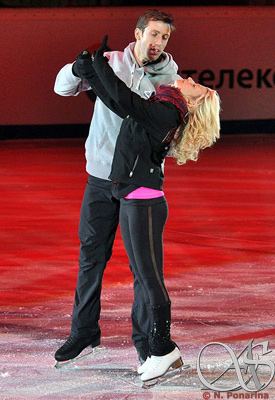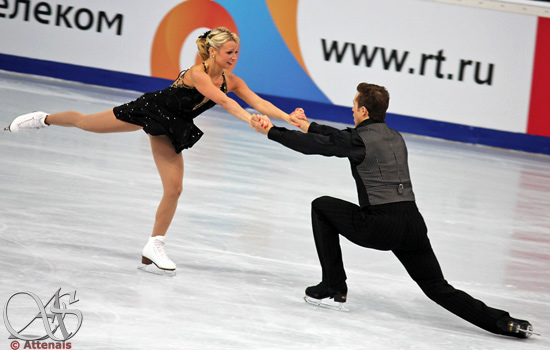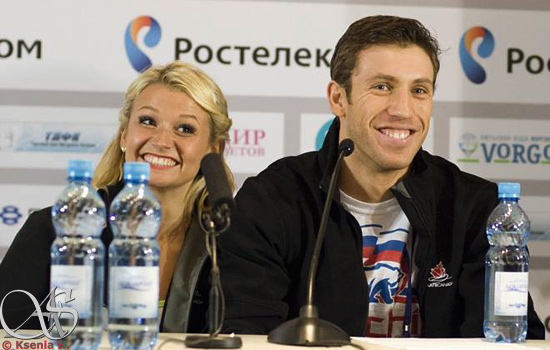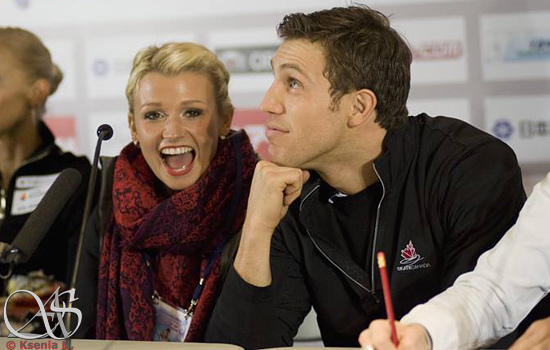Catching up with Kirsten Moore-Towers and Dylan Moscovitch
December 6, 2013
By Reut Golinsky
Photo © Irina Teterina (Attenais), Ksenia Nurtdinova, Natasha Ponarina
 Dylan David Moscovitch claims that he started to skate when he was 13 months old; his parents took him to the rink with them but were not allowed to carry him on the ice, so he had to wear skates too. He competed both in singles (silver at Junior Nationals in 2004) and in pairs with his sister Kyra (they were pre-novice, novice and junior national champions in 2004-2006, respectively).
Dylan David Moscovitch claims that he started to skate when he was 13 months old; his parents took him to the rink with them but were not allowed to carry him on the ice, so he had to wear skates too. He competed both in singles (silver at Junior Nationals in 2004) and in pairs with his sister Kyra (they were pre-novice, novice and junior national champions in 2004-2006, respectively).
Kirsten Moore-Towers first put on skates when she was 2 years old. As a singles skater she won pre-novice bronze at Nationals in 2006 and novice gold at the Canada Games in 2007. She also competed internationally in pairs with Andrew Evans.
Following Kyra's retirement Dylan and Kirsten teamed up in the spring of 2009. Pretty quickly they drew the skating universe's attention, not only with their impressive international results (7 Grand Prix medals in four seasons and twice top five at Worlds) but also with their positivity, humor and charm off the ice.
Just before the start of their third Grand Prix Final, Dylan and Kirsten found some time to answer our questions about the story behind their short program costumes, the "choreography" of their pre-skate routine, and more.
Why did you decide to keep your last season's short program?
Dylan: We had such great feedback after last season about our short program and it was strongly suggested that we keep it. As a team, we decided that we should try something new first. After choreographing a new short to "Sing Sing Sing" and training it for a couple of weeks, we realized that the short from last season was the way to go.
Kirsten: We enjoy skating it and feel that it suits us and will be a good Olympic program.


The costumes for this program are very stylish and unusual, but I wondered how are they connected to the film, "Micmacs", or the music?
Dylan: The costumes are tied more to the quirkiness of the music and the characters of the program. Our choreographer felt that the look of the program needed to have some sort of an odd flavor to it so that the whole story would come together well.
I know you also had a different long program prepared. Why did you change it?
Kirsten: It was beautiful, but it wasn't suited to our personalities and characters on the ice. We would love to do something like it in the future but for now, Fellini (their long program is choreographed to the medley of soundtracks to Fellini's films –ed.) was the best fit. We didn't want to venture too far out if our comfort zones in an Olympic year.
 Kirsten, I heard that you may have a new dress for the long program, right?
Kirsten, I heard that you may have a new dress for the long program, right?
Kirsten: Yes, you will see my new long program dress this weekend at the Grand Prix Final.
Any reason why you chose such a sad ballad for your exhibition program? I actually really loved the funny one you had last season, I think it suited your personalities.
Kirsten: We chose "Everybody hurts" by R.E.M. for our show program because we wanted something different and something emotional. We love the song as well. We will be creating a funnier piece to perform later in the season or just in shows. Stay tuned. (smiles)
You mentioned in one of your interviews that there are many themes and styles youÂ’d still want to try. For example?
Kirsten: Dylan and I are both interested in trying a tango. We also both like blues style programs. Perhaps those are in our future.
Usually, what is the process of choosing music and trying programs for your team? How early in the season do you start to think about the next season's programs? What should the music, program, and choreography have so that you'll feel it is the "right" one?
Dylan: Mark Pillay, our choreographer, usually starts formulating ideas for our programs about a year in advance. He starts bouncing ideas off Kris and Kristy (Kris Wirtz and Kristy Sargeant-Wirtz), our coaches, about half way through the season. After our season is finished we usually sit down with him or speak over the phone and go over some of the ideasÂ… usually quite soon afterwards. For a program to feel like the right one the music has to sit comfortably with both of us and the choreography process is quite organic, with all of us giving input.
 Do you think that Olympic programs have to be even better? Did you give special attention to this season's programs?
Do you think that Olympic programs have to be even better? Did you give special attention to this season's programs?
Dylan: I don't think that the programs have to be necessarily better, but they have to be the right choices. They have to be ones that exhibit our strengths and complement our skating styles all the while making us feel inspired and comfortable while skating them.
You work once a week with a dance teacher. Why do you think this is important? What are you working on with him?
Dylan: The second mark is what separates most of the teams at the top. Emoting as well as moving our bodies is essential to capturing the feel and look of a character or mood in a program. We work on facial expressions as well as how we are moving our bodies. We work on everything from basic lines to movements specific to the style of the choreography.
Where were you four years ago during your home Winter Games?
Dylan: I was on a snowboarding vacation with my dad and brother in Utah. But I was definitely watching and thinking about Sochi, excited for my turn.
Kirsten: During the 2010 Olympics I was glued to the TV in Waterloo, Ontario. Of course I was thinking about Sochi. I wanted and still want to be there very badly.
 What do you think about the team event in Sochi? If it is decided that you will split it with Meagan/Eric, which program would you prefer to skate, short or long?
What do you think about the team event in Sochi? If it is decided that you will split it with Meagan/Eric, which program would you prefer to skate, short or long?
Kirsten: I think the team event is very cool! And it would be special to compete in it and be some of the first people ever to partake in such a thing. We would be happy to skate either program!!
Dylan, compare competing with your sister versus with someone who is not. Pros and cons.
Dylan: Competing with my sister was very different in so many ways. We were both new to pairs and she was only 9 when we started and I was 18. It was very much me being the older brother and guiding her along. For a few of the years we skated together we lived away from home so I also had to play a parental role. It definitely added a different dynamic to the partnership than most others would experience. However, we learned to be in sync very quickly. And doing well with her was sentimental in a different way because she was my baby sister.
Kirsten over the years has become like my sister. We are very close and she feels like my sister in many ways. But we can also do romantic styles without it looking funny. (laughs)

Dylan, your second name is David, is this something coming from family or does it have some interesting story? It's just King David is one of my favorite Biblical figures.
Dylan: My middle name David came from my uncle David, my mom's younger brother, who died right before I was born. It is also my Hebrew name.
Dylan has already shown us his broad knowledge in languages with “ni hao” and “da” during a press conference in Moscow. Kirsten, what languages do you speak?
Kirsten: My strongest second language is French. However, I understand better than I speak. We tend to pick up the common words like "hello", "how are you", "thank you", "goodbye" in all the countries we go to.

And the last question, which I absolutely must ask, is: what does the "ritual" handshake you do with Kirsten before skating mean? Where and when did it originate?
Dylan: (laughs) This is our pre-game handshake. We usually make a new one every year. This one is the same as last year but with add-ons. We do this before every competition and have a pre-game hug.
Thank you very much for your answers, Kirsten and Dylan. And good luck with your Grand Prix Final performances!




